On the occasion of my visit to the US in April, three powerfully moving experiences illustrated the marvel of the struggle to strengthen and refine the interplay of civil and human rights in the American culture that continues to give me hope that a democracy of inclusiveness is not lost there. They were disparate experiences – in Richmond, Atlanta and Washington, DC – but they all combined to renew my hope in the American culture – and in inclusiveness as a fundamental value of cultures generally.
First, I attended an event on 23 April 2019 to honor the second annual Barbara Johns Day in Virginia. She was a leading figure in the Brown v. Board of Education decision issued by the US Supreme Court in 1954, but the impact of what she did reverberated throughout the State of Virginia and the country at large over the decades that followed – and even today almost 70 years from the fateful 23 April of 1951 when she became that leading figure.
Second, I happened upon a new Center for Civil and Human Rights in Atlanta, where I was attending a regional conference for the White House Fellows program at the Carter Presidential Library and Center. The conference was great, but the Center was a revelation for the penetrating linkages between the civil rights movement and the global scope of human rights.
And third, I was back in the capital of Washington, DC where family visitors suggested a visit to something called the “Newseum”, a serendipitous venture into the history, current state and future dilemmas of the role that freedom of the press has to play in the promotion of those same civil and human rights.
The First Event in Richmond
The first event in Richmond was held at the Black History Museum and Cultural Center on 23 April 2019, the second official Barbara Johns Day in the State of Virginia. Hosted by the Democratic Party of Virginia, it was actually the fourth annual such event for the Democratic Party there.

It featured a panel and reception with special guest Eric Holder, the former US Attorney General under President Obama and currently chair of the National Democratic Redistricting Committee. His presence gave the event a poignantly relevant current tone to the challenge of racial divisions in the US as he described his commitment to making voting rights appropriate for all and to ending voter suppression.
The panel, moderated by Virginia State Senator Jenn McClellan, included three other speakers, all of whom focused more directly on the history and reverberating impact of what Barbara Johns did on that significant 23 April of 1951.
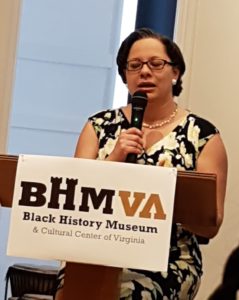
One of the speakers was Joan Johns Cobb, the 80-year-old sister of Barbara Johns, who read a movingly detailed account drawn from Barbara Johns’s personal diary, about what she did. Amazingly, we learned, this 16-year-old high school student in a segregated school in Farmville, Virginia, had the courage and determination to “do something” about the inferior quality of the black school compared to the white school – a ramshackle structure spilling out into tarpaper shacks for 450 students – compared to the white school with its generous and solid complex featuring laboratories, a gym and a cafeteria.
It was her music teacher, who told her that, if she wanted better school accommodations, she should “do something” about it. And it was triggered by an event when she mad missed the typically overcrowded black school bus in her rush to get all of her younger siblings ready for school and forgetting her lunch, that she saw the “whites only” school bus passing by half empty and said to herself that this was just not fair. One has to be truly amazed at what she then did. She orchestrated an unannounced assembly of the 450 or so students by forging an announcement from the school principal, and when they gathered, she was the one who spoke from the stage urging a walk-out of all the students to protest the inferior conditions and demand a new school building. And the students actually followed her out of the building!
A two-week student strike had to have been quite an ordeal, including a lot of parental pressure and threats from the school superintendent directed at the parents, if not directly on the students. But when the students returned, Barbara Johns didn’t give up the cause. She took the initiative to call the NAACP office in Richmond and asked for help with legal action to get the new facilities that they all wanted. In response to her persistence, the NAACP lawyers ended up taking the case – but only if the legal argument was altered from a demand for separate but equal facilities to actually integrating the black and white schools. The case, filed as Davis v. County School Board of Prince Edwards County, was one of five cases brought by the NAACP Legal Defense Fund under the leadership of their Chief Counsel Thurgood Marshall. These were ultimately consolidated under the Topeka, Kansas case, along with others from South Carolina, Delaware and Washington, DC on appeal to the US Supreme Court. While there were indeed five parallel cases, the impetus for the appeals was stimulated by the large number of plaintiffs in the Davis case (75 per cent of the total).
What a story! Barbara Johns withstood threats once she had mobilized the student strike, and her family had to send her off to an uncle in Montgomery to finish high school. She later earned a degree in library science and worked as a librarian in the Philadelphia school system. Meanwhile, as we learned from the other panelists, the Prince Edward County School Board did not respond favorably to the Supreme Court’s ruling in Brown v. Board of Education. And even though the opinion was unanimous, it did leave things a bit up in the air as to how to end the practice of school segregation. A follow-up case, known as “Brown II”, encouraged the ending of segregation “with all deliberate speed”, but this was taken to mean “slow and whoa” among the predominantly Southern resistance to the rulings. In fact, in Virginia this took the form of the “Massive Resistance” led by the Virginia US Senator Harry F. Byrd in the 1950s and 1960s.
The Prince Edward County School Board was among the Virginia school boards that simply closed all public schools and saw the formation of “private” white schools in their place. For the black students of Farmville, this meant no school at all for the five years between 1959 and 1964 that Virginia was able to get away with this outrage. One of the other panelists at this Richmond event, James Ghee, was one of them. His only recourse was to receive the backing of the American Friends Service Committee to send him off to Iowa, where he actually went to an otherwise all white high school. He eventually trained as a lawyer and returned to Farmville, where he has played an instrumental role since then of leading the community beyond this unfortunate period. Mr. Ghee also described the key role of the Rev. L. Francis Griffith, who mobilized the nonviolent actions to open the public schools again in 1964.
The fourth panelist, Ken Woodleigh, brought another perspective to this saga.

In his case, as a fledgling white journalist and then publisher of the local paper in Farmville, he came around to appreciating the damage that segregation – and the subsequent “Massive Resistance” had done to the black community in Farmville, and especially the young students who missed out on five years of schooling when all of the schools had closed. The result, as described in his book The Road to Healing: A Civil Rights Representative’s Story, was to lobby for state-funded scholarships for those who had had no schooling in those years. This was evidently approved, finally, by the Virginia General Assembly in 2003. What a truly reverberating history!
By the way, later in the visit to Richmond, I went with Kristina and Julian to find the Civil Rights Memorial on the Richmond Capitol Grounds, where Barbara Johns is memorialized. It is an impressive memorial with 18 statues, some representing individuals and others representing the students and adults who were part of this awesome challenge to segregation. Here are the four sides of that memorial.

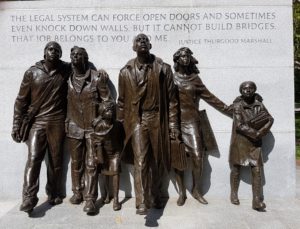


The Second Event in Atlanta
Second, the Center for Civil and Human Rights is an attraction that we should all have known about as we planned our brief visit to Atlanta for a regional conference of White House Fellows at the Carter Presidential Library and Center. Oddly enough, we knew about the Martin Luther King Jr. National Historic Park and Center for Nonviolent Social Change, plus the Olympic Park and the World of Coca-Cola Center – and, oh yes, the CNN World Center. But the Center for Civil and Human Rights? Not really.
My son PJ and I had traveled together to Atlanta and had an afternoon to explore the sites before an evening reception at the Carter Center conference. As we walked along the busy mid-town Atlanta streets near our hotel, we came across what we eventually saw from a distance as the Georgia Aquarium and also saw another sign pointing towards the World of Coca-Cola Center.

We shrugged our shoulders and discussed which one to choose when we noticed that we were looking straight at some sculptures of yet another complex marked as the Center for Civil and Human Rights. By then, we were inclined to go to whatever was the closest, and this turned out to be the Center for Civil and Human Rights. Lo and behold, it turns out that all three are part of the same complex built around something called Pemberton Park (named after the founder of and owned by the Coca Cola Company).
In this case, I think we can say that we chose wisely. And we liked what we saw. The Center which opened in 2014, starts with a floor featuring the “Voice to the Voiceless”, a collection of the papers of Martin Luther King Jr. that are shared with Morehouse College. Then there is a floor where the theme is “Rolls Down Like Water” which is all about the American civil rights movement, and then, a top floor entitled “Spark of Conviction” which features the global human rights movement, based on the Universal Declaration of Human Rights. Some critics seem to think that the Center covers way too much without a clear focus (especially on this top level depicting various human rights movements), and also that it is vulnerable to being commercialized by being adjacent to both the Georgia Aquarium and the World of Coca-Cola Center.
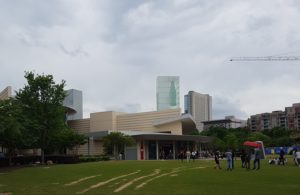
One can observe, as with most other cultural centers or museums, the acknowledgements to a long list of private benefactors. Prime among them are philanthropists associated with Delta Airlines, Home Depot, the Atlanta Falcons and Coca-Cola, as well as AT&T, Wells Fargo, Siemens, Ted Turner, CNN and a host of other corporate-related donors. The idea for the Center, however, originated from civil rights leaders who supported the idea of linking the American civil rights movement to the global human rights movement, regardless of how disparate and erratic the linkages might be. And what caught my eye in particular was a name I immediately recognized from my days with the International Labor Organization, Ed Potter, with the name of his spouse Regina Olchowski just alongside! Ed was for many years the US Employer Spokesperson at the ILO Conference and Governing Body. And while he had initially become active with the ILO as the head of the Washington, DC-based Labor Policy Association, he moved to Atlanta some years ago to be the Chief Labor Counsel for the Coca-Cola Company. So maybe there is a strong Coca-Cola influence here, but I think it is a well-intended support for a truly provacative look at both civil and human rights.
The top level display on global human rights has a section devoted to an “ethical footprint challenge”, and I immediately thought of Ed as I surveyed the topical issues covered there. There are columns devoted to the issues of child labor in the chocolate and soccer ball industries – cross reference the International Cocoa Initiative or the Sialkot imitative on soccer balls, both of which have involved action from the ILO. Women’s issues and occupational safety issues in clothing (the Rana Plaza disaster in Bangladesh) and flowers (the cut-flowers industry in Ecuador and Colombia) have separate columns, while palm oil producers (in Indonesia and nearby countries) are targeted for both environmental and human rights abuses. And cell phone manufacturers have been challenged by their links to rare minerals in conflict zones in Africa where the human rights abuses are across the board. I really liked this particular section, as well as the thought-provoking array of issues that this display on global human rights covered.
As for the mid-level display on the evolution of the American civil rights movement, I was personally struck by the contrasting sides of segregationist portraits and Jim Crow laws, on one side, and the emerging challenges for dismantling a segregated society, on the other. My son PJ was especially stunned by sitting at the mock lunch counter, replicating the sounds and movements of the sit-ins at lunch counters like the one in the Woolworth’s downtown store in Greensboro, NC. Just three years ago, we had actually visited that same Woolworth’s site in Greensboro, which is now its own Civil Rights Museum honoring the start of the sit-in movement there in 1963.

I also appreciated the overview of the Brown v. Board of Education ruling that linked the visit to my having just learned about the role that Barbara Johns played in the ruling. And especially moving for me personally were the depictions of the 1963 march on Washington, which I actually watched on a small television in Edina, Minnesota with my mother in August of that year. What a memory!
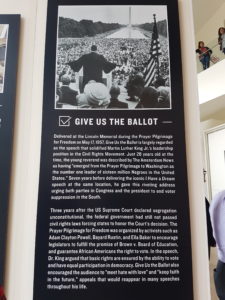

Needless to say, the African American Museum in Washington, DC has by far the most comprehensive and informative coverage of the history of civil rights in the US, but I am heartened to see that this kind of history is penetrating elsewhere, including the crucial home base of Atlanta for both the Rev. Martin Luther King, Jr, and the civil rights community at large. And I also think that the bold effort to connect this to a broader challenge of what we all mean by global human rights is a good thing, too.
And I would add one more thing here. Last year, I wrote a musing about an exhibit right here in Grasse entitled “MLK Après 50” that had been sponsored as a touring exhibit by an alliance of French Protestant groups. It was, indeed, the 50th anniversary of the Rev. Martin Luther King Jr’s death (1968). (See the musing here at http://katherinehagen.net/the-mlk-apres-50-exhibit-and-the-legacy-of-halloween/#more-29573.) The exhibit emphasized the religious roots to the American civil rights movement, as well as the links to the original Martin Luther, who posted the 95 theses on the Wittenham church door on 31 October, 1617. (In fact, this same group of French Protestants had celebrated the 500th anniversary of this event with another exhibit back in 2017, but that is another story.) What I do remember about my reactions to the exhibit in Grasse was that the concept of non-violent resistance to repression that was the underpinning of the American civil rights movement is challenged today by our search for finding ways to absorb often alien-appearing cultures into our established communities. Linking the history of the American civil rights movement to global human rights issues, as the Atlanta Center for Civil and Human Rights has done, is certainly one way to advance this dialogue and promote these linkages.
The Third Event in Washington, DC
Third, there is the phenomenon of the “Newseum”. My sisters were the ones who suggested this. Elizabeth from Richmond, Virginia and Jan from Madison, Wisconsin had made special efforts to travel to Washington, DC for a 24-hour three-sisters reunion on the day before my scheduled return to Grasse. The last time we had gathered together for a sisterly visit was in 2016, even though we had also socialized at the lively wedding celebration for my daughter Kristina and son-in-law Julian in 2017. But we rarely get together since we all live so far apart. This was, then, a welcome finale to my April trip to the States.
Well, we do like to sit around and kibitz, and we did a bit of that, to be sure. But we are all three of us looking for ways to DO things together. So when Jan and Elizabeth suggested the Newseum, I happily agreed, vaguely remembering that this was one of those DC museums that was about to close down for good. I think we can all agree that we truly regret that this is about to happen. Reports are that it will close in 2020, the site already sold to Johns Hopkins University for an expansion of its academic programs. It is good to have a museum devoted to the importance of a free press and the First Amendment – encompassing religion, speech, press, assembly and petition – but all from the perspective of how the free press makes all of this possible. But a section on “American Presidents and Their Pets” is not exactly relevant, and yes, it’s good to see all of today’s front pages from all around the world and all 50 states. But that has no editing value, to speak of. So maybe the spread of the Newseum had a bit of overkill to it.
What I did enjoy were the sections of the museum on the history of the press from 1495 on (shortly after the invention of the Gutenberg Press that revolutionized communication at the beginning of the 16th century – e.g. Martin Luther’s posting of the 95 theses comes to mind) to the world of today. Things like the Alien and Sedition Acts of the 1790s in the US or the devastation of World War I or the concentration camps in World War II are parts of the history of the Western world. There are also major events like the end of apartheid in South Africa or the Camp David Accords between Israel and Egypt or the invasion of Iraq or you name it. The original documents were there to see in quite a remarkable chronology, complemented with a series of window displays.
The other two sections of the museum that I especially liked included one on the World News Gallery, which had a direct connection to the global human rights section of the Atlanta Center on Civil and Human Rights There it was: in both museums, a global map ranking degrees of political freedom (Atlanta) and of freedom of the press (DC). I note that both maps came from the same source, Freedom House, although with a different number of categories (four for political freedom and three for freedom of the press). (See their website here: https://freedomhouse.org). In any case, the Newseum piece had an extensive presentation on the challenges of fake news, especially in the US. It ranked Norway, by the way, as the most free on press matters. And the final section of the Newseum that I liked dealt with the issue of freedom of the press on the Internet, where emerging issues are still challenging us to address privacy, security and censorship. This was also featured in the Atlanta Center on Civil and Human Rights as a worrying effect on human rights.
We actually went back for a second day to see more of this museum, and on this second day, we brought Kristina, Julian, PJ and Sarah along with us. Here is a group photo of our visit. 
And here we are discussing the significance of what we had seen, each of us in lively debates.

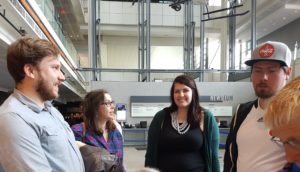
Conclusion
In conclusion, I found the three experiences in Richmond, Atlanta and Washington, DC to renew my optimism about the future of democracy, civil rights and human rights, but especially about the capacity of people to find ways to live together and even to broaden their sense of community. The hatred, violence and divisiveness that are so hurtful won’t go away just because we find them so incompatible with humanity, but we also have a strong presence in both American and global values of a fundamental respect for compassion, peace and inclusiveness. I think they are shared values in every culture. I welcome the role that museums and cultural centers have in inspiring us to embrace these values in our daily lives. And thanks, too, to the dear friends and family (Elizabeth, Jan, Kristina, Julian, PJ, Sarah – and yes Wade and Larry and Marti and all my White House Fellows friends and other dear friends whom I saw on this particular visit) who keep this optimism alive.


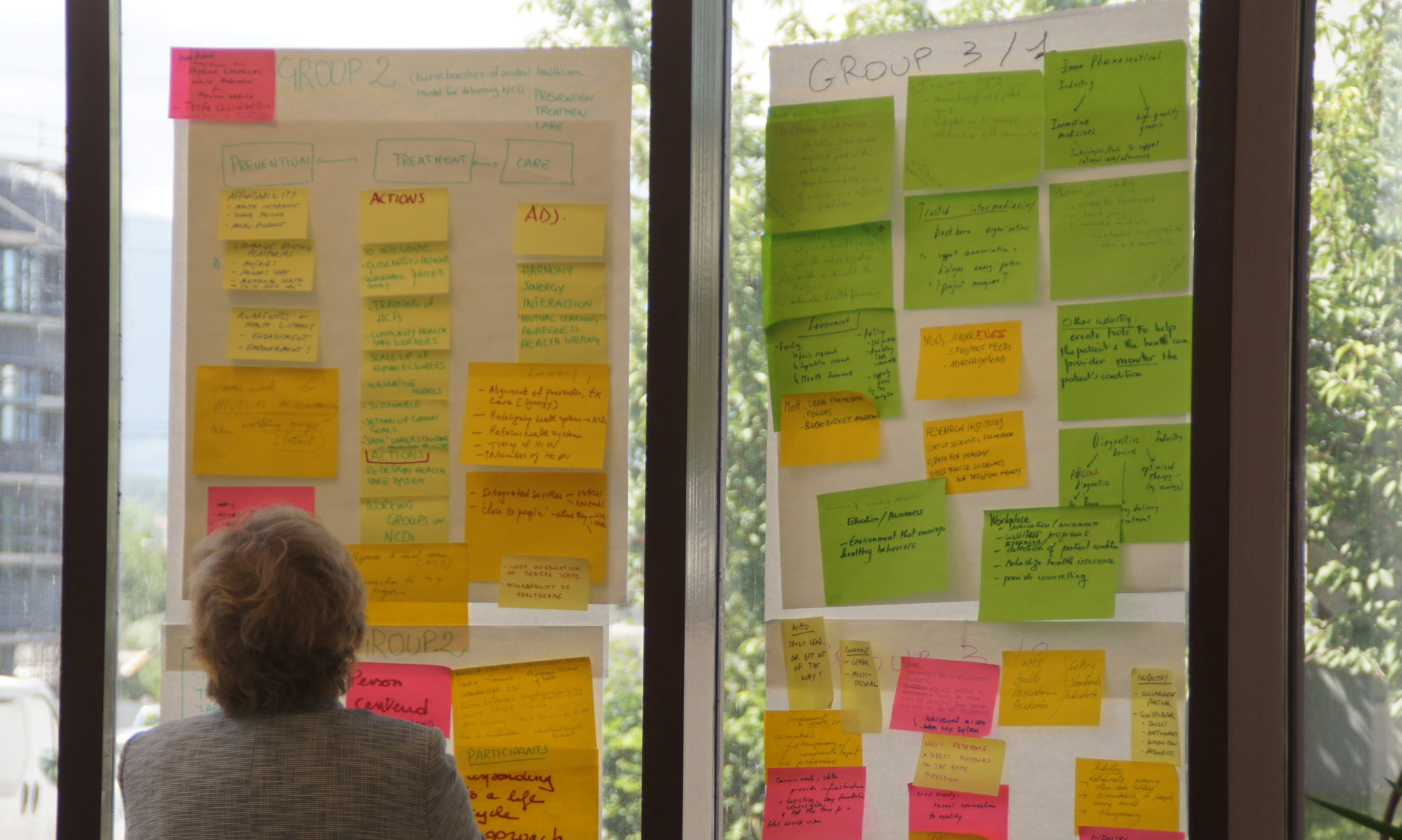

The Newseum, unfortunately, has not generated enough revenue to keep its facility, and the property was recently sold to Johns Hopkins which intends to open some branch of the university there. Don’t know what will become of the amazing collection at the Newseum.
We enjoyed the Newseum and made a special point of going there knowing that it was going to close. It really is too bad that it didn’t make it. Although there were certain exhibits that were silly (e.g. White House dogs), mostly it provided an informative overview of the history of news reporting, along with some thematic contemporary exhibits.